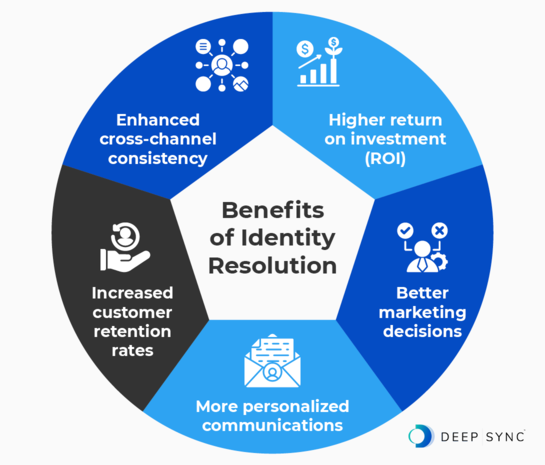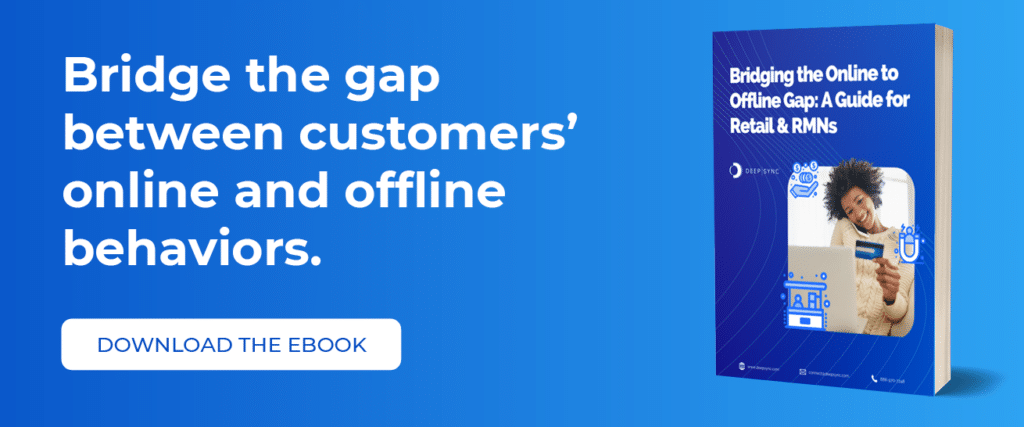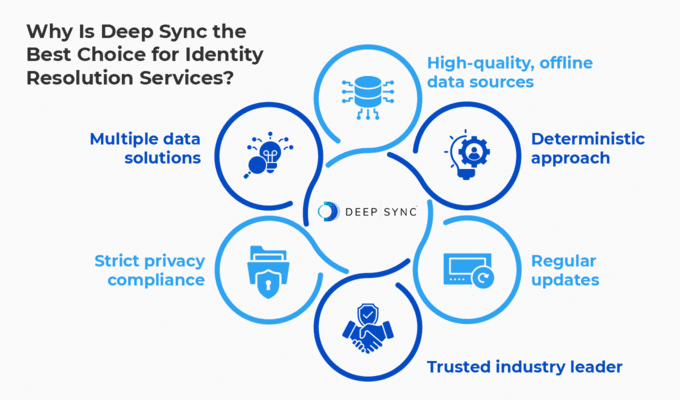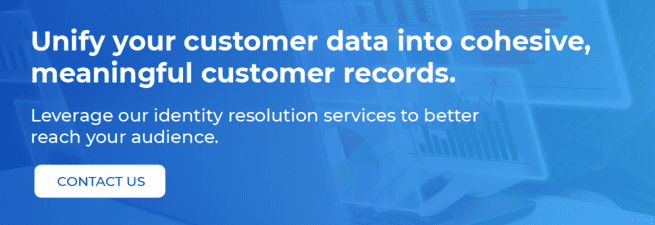Even though third-party cookies are here to stay, many marketers are looking for a long-term solution that is both accurate and privacy-conscious. In light of cookie instability, marketers are now prioritizing high-quality, first-party data to effectively reach their audiences.
First-party data that you collect from your customers—like names, contact information, and home addresses—allows you to keep in touch with your customers and spread the word about your products and services. However, this information can be prone to errors, and it won’t stay accurate forever.
Your audience members are constantly moving, growing, and changing, causing their data to change as well. Plus, with so many customer data points collected across various touchpoints, it can be difficult to get a comprehensive view of each customer and avoid duplicate contacts in your database.
That’s where identity resolution comes in. With identity resolution services, you can attribute an individual customer’s identifiers to a manageable, singular, and up-to-date profile. In this guide, we’ll cover the basics of identity resolution by answering the following questions:
- What Is Identity Resolution?
- Why Is Identity Resolution Important?
- How Does Deep Sync’s Identity Resolution Process Work?
- Why Is Deep Sync the Best Choice for Identity Resolution Services?
Let’s start by exploring exactly what identity resolution is and the different types your brand can leverage.

What Is Identity Resolution?
Identity resolution is the practice of combining disparate identifiers into a single customer identity. Since your customers interact with your brand across various platforms, channels, and devices, you may collect different pieces of information about them from different sources.
Through identity resolution, you can unite all of this information into comprehensive customer records, allowing you to:
- Identify specific audiences for targeted marketing campaigns.
- Create custom marketing messages and creatives that enhance the customer experience.
- Seamlessly integrate offline and online data for cross-channel marketing.
- Establish consistent, cohesive messages across all touchpoints.
- Attribute actions back to individual customers.
- Better manage ad frequency and eliminate wasted ad spend.
By working with a data provider like Deep Sync, you can conduct the identity resolution process using accurate, scalable, and privacy regulation-compliant solutions.
What’s the Difference Between Probabilistic and Deterministic Identity Resolution?
There are two main types of identity resolution: probabilistic matching and deterministic matching. Let’s take a look at these two approaches and the differences between them:
- Probabilistic identity resolution resolves customer identities to a likely match based on predictive algorithms and heuristics. Since predictive algorithms can have a wide margin of error, you can’t trust that they’ll have an acceptable level of accuracy. Even small mistakes can lead you to create inaccurate customer profiles and incorrectly target your audience members.
- Deterministic identity resolution uses authenticated data to ensure identities are resolved at the highest levels of accuracy. It matches various data points, such as phone numbers and device IDs, to individual profiles without predictive algorithms. Since this method only matches data points together when there is a determined match, you can be highly confident in the accuracy of the resulting customer identities.
With so much uncertainty about third-party cookies, durable, privacy-compliant methodologies are the best path forward. Therefore, the best identity resolution method is a deterministic approach because it relies on personally identifiable, authenticated, or self-declared information instead of predictions based on patterns or behaviors.
What’s the Relationship Between Addressability and Identity?
You may hear the terms “addressability” and “identity” tossed around in the digital marketing world quite often. While the concepts are interconnected, they are distinct from each other, and understanding the nuances between them can provide some much-needed context to your audience targeting efforts.
Addressability refers to the number of individuals you can reach with a campaign. While mailing lists used to be at the heart of one-to-one marketing, programmatic advertising has expanded the addressable audiences available to marketers.
However, since brands have identified third-party cookies’ flaws, they need more reliable ways to reach their audiences; that is where identity resolution comes into play.
As our GM, Digital, Paul Turner, puts it, “Identity resolution is the necessary foundation upon which addressability is built.” High-quality data that you can tie back to each individual through a deterministic match process allows you to be confident in who your individual audience members are and scale your efforts accordingly. Clean, accurate data should be the starting point for expanding your reach.
Why Is Identity Resolution Important?
By now, it should be clear that identity resolution is the key to creating cohesive customer profiles. However, you may still be wondering why you need these profiles in the first place and how they can upgrade your marketing efforts.
Besides keeping your customer data organized and easily accessible, there are several benefits you can expect from introducing identity resolution into your business’s operations:

- Better marketing decisions. When you fully understand individual customers and your audience as a whole, you can make more well-informed decisions based on these insights. From selecting the channels you’ll use to reach your audience to tailoring your products and services to their needs, you can base your strategy on data instead of assumptions or trial and error.
- More personalized communications. Customer expectations are at a record high, with 79% wanting brands to demonstrate that they understand and care about their unique needs before even making a purchase. By creating unified customer profiles, you can deliver more relevant, personalized marketing messages to your customers that encourage them to support your business.
- Increased customer retention rates. Through these more personalized communications and interactions, you’ll improve customer retention. Customers are more likely to show loyalty to a brand when they feel valued as individuals and receive messages that speak to their unique pain points.
- Enhanced cross-channel consistency. Display the right messages to the right customers at the right time on the right channels. With a unified view of each customer, you can target them with cohesive, relevant messages across channels instead of serving them different messages on each channel they use to interact with your brand.
- Higher return on investment (ROI). By avoiding duplicate messaging and optimizing your marketing campaigns based on your customers’ unique preferences and needs, you can improve your return on marketing investment. Plus, when you retain customers through more personalized marketing efforts, you’ll spend less on customer acquisition costs, boosting your ROI even more.
Between offering a more tailored customer experience and making it easier to get the most out of your marketing spend, identity resolution offers a win-win situation for your audience members and your team.

How Does Deep Sync’s Identity Resolution Process Work?
First and foremost, Deep Sync uses a deterministic matching process to accurately attribute identifiers to specific customers and build unified customer profiles. These identifiers include full names, postal addresses, email addresses, phone numbers, IP addresses, and mobile IDs.

We use our exclusive persistent identifier, the Deep Sync ID, to link offline data—like name, postal address, and phone number—to online data—like MAIDs, UID2s, Hashed Emails, and IP addresses. This allows us to resolve your records to singular, unified customer profiles. So, you can be confident that the resulting customer profiles are accurate and ready for your team to leverage in its marketing strategy.

Why Is Deep Sync the Best Choice for Identity Resolution Services?
With various data providers or platforms to choose from, why should you trust Deep Sync for your identity resolution needs?
Deep Sync’s identity resolution services stand out from the crowd for the following reasons:

- High-quality, offline data sources. Because our data comes from high-quality, offline sources, third-party cookies have never been part of our compilation methodology. Our identity spine covers 97% of U.S. consumers and 85% of U.S. businesses and is powered by highly-exclusive postal data updates, making our dataset one of the most accurate in the industry.
- Deterministic approach. Our deterministic offline data is connected to billions of digital identifiers, including email addresses, mobile ad IDs (MAIDs), IP addresses, and more, allowing for offline-to-online identity resolution. We apply these identifiers at the individual and household levels, so you can target individual customers or their entire households.
- Regular updates. We update our identity spine weekly to ensure it’s accurate. That way, you can keep up with customers who have moved, gotten new phone numbers, or gone through other life changes without missing a beat.
- Trusted industry leader. With more than three decades of experience, our team has paved the way for data-driven marketing solutions. Our data powers about 5% of all U.S. mail sent each year. In addition to working with agencies and brands directly, we license our own data assets to many of the nation’s leading data providers.
- Strict privacy compliance. We observe all federal and state-level privacy laws and regulations. We accept and process opt-out requests from consumers in all states, regardless of whether it’s required by state law, so you can maintain trust with your customers and avoid targeting consumers with unwanted messages.
- Multiple data solutions. In addition to our identity resolution services, we offer data hygiene, enhancement, customer profiling, and digital targeting solutions to strengthen the usability, accuracy, and completeness of your first-party data even further. Reach your audience via social media advertising, programmatic advertising, Connected TV advertising, email marketing, and direct mail—all by working with the same data team that understands your business and its needs.
By partnering with the industry leader in deterministic identity, you can unlock unparalleled customer insights and take full advantage of Deep Sync’s premier data assets and solutions for better audience targeting and reach.
Simplify Your Identity Resolution Process with Deep Sync
Customers interact with your brand in various ways, from your website to social media to brick-and-mortar shopping. And, outside of your business, your customers possess different qualities that make them unique.
Identifying exactly who your customers are is the key to more successful, personalized marketing. By unifying online and offline identifiers, you can create cohesive customer profiles to customize your messages and interactions, focus your marketing efforts, offer a better customer experience, and boost your marketing ROI.
As the industry leader in deterministic identity with more than 30 years of experience in data quality, hygiene, and identity resolution, Deep Sync can supercharge your identity resolution efforts. If you’re ready to get started with identity resolution, book a strategy session so we can discuss our services and your business’s needs.
If you want to learn more about data-driven marketing before diving into identity resolution services, check out the following resources:
- Understanding Deterministic Identity: The Key to Effective Marketing. Deterministic data is at the core of identity resolution. Learn more about this type of data, how to collect it, and how to leverage it.
- CTV Targeting: How Deterministic Data Powers Campaigns. CTV targeting allows you to apply the deterministic data you receive from identity resolution services. Explore the fastest-growing advertising channel in the United States and how our identity spine can power your CTV campaigns.
- What Is Data Enrichment? How To Unlock Marketing Insights. Data enrichment supplements your first-party data with third-party data for a more holistic view of your customers. This guide will teach you all about the data enrichment process and how you can get started.














0 Comments